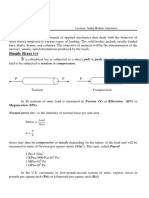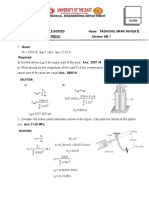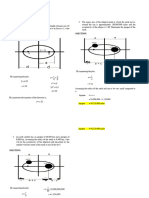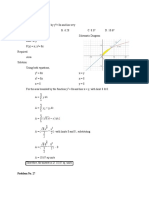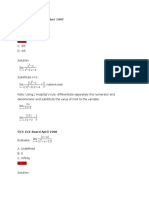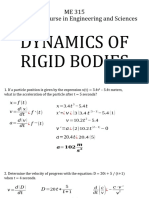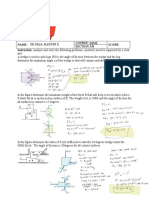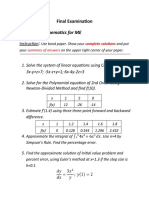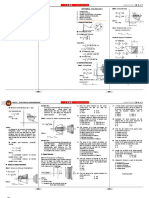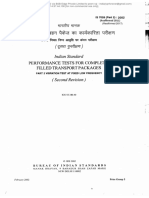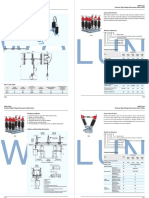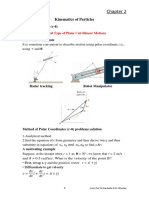1/3
1 Solution:
DYNAMICS 1: 1 S V0 t at 2 formula
V0=0
S = V0 t ± at 2 2 1
2 2
S A 6 t 0.5 (1.5 ) t 2 H Vt gt
LINEAR MOTION h=?
2
V = V0 ± at
A body is said to be in linear motion, if the path SB 18 t 0.5 ( 0.9 ) t 2 2 V=?
5 V ( 0.3) 0.5 ( 9.81)( 0.3)
traced by it is a straight line 2 2
V = V0 ± 2aS V 15.195 ft/s
S A SB 115.2
a) Linear motion with constant velocity H=5
EXAMPLE 1: A train running at 30 m/s is slowed 6t 0.75t 2 18t 0.45t 2 115.2 t=0.3
V 2 V0 2 2 gh
uniformly to a stop in 44 s. Find the stopping
Note: The velocity of the body is constant all t 16 s or - 6 s (absurd root)
throughout the period
distance. 15.1952 0 2 ( 9.81)h
h 11.768 m
Solution: VERTICAL TRAVEL:
t
Theory: Any body thrown freely up or down, will be DIFFERENCE IN HEIGHT OF BODIES THROWN UP
V V = V0 - at a (Optional Solutions Only)
V0=30 V =0 subjected to acceleration due to gravity (g).
0 = 30 - a(44)
t=44
S For a body traveling downward, the body is t
a 0.68 m/s2 V0
accelerating (speeding up) while for a body traveling t
S END
up, the body is decelerating (slowing down).
S = horizontal distance traveled 1 2 Standard values of g:
V = velocity S V0 t at START V0 V
2 V
t = time consumed in traveling distance S g = 9.81 m/s2 -H +H
S 30 ( 44 ) 0.5( 0.68)( 44 )2 661.76 m = 981 cm/s2
S Vt = 32.2 ft/s2 END START
t H V
ALTERNATE SOLUTION to solve distance S:
V0
Note: This topic was lectured in Algebra
2 2 1
V V0 2 aS H = V0 t - gt 2 ; V 2 = V0 2 - 2g( H)
b) Linear motion with constant acceleration:
2 2
0 30 2 ( 0.68 )( S ) H = vertical distance traveled
Acceleration – change in velocity with respect to S 661.76 m V0 = initial velocity; V = final velocity EXAMPLE 4: A particle of dirt falls from an elevator
time t = time consumed in traveling distance S
that is moving up with a velocity of 3 m/s. If the
EXAMPLE 2: Car A is moving at 6 m/s and is g = gravitational acceleration particle reahes the bottom in 2 s, how high above
Horizontal motion: accelerating at 1.5 m/s2 to overtake car B which is + sign = body is moving down
the bottom was the elevator when the particle
115.2 m ahead. If car B is moving at 18 m/s and is - sign = body is moving up started falling.
t decelerating at 0.9 m/s2, how soon will A pass B?
V=0
V0 V 1
a Solution: H = V0 t ± gt 2
2 H t1
V = V0 ± gt t2=2-t1
S aA =1.5 aB =-0.9 V0=3
h
S = horizontal distance traveled V 2 = V0 2 ± 2gH
V0 = initial velocity; V = final velocity
t = time consumed in traveling distance S
115.2 SB EXAMPLE 3: A man standing at a window 5 m tall V2 V02 2gH
a = acceleration
watches a falling ball pass by the window in 0.3 s.
+ sign = body is speeding up SA How high above the top of the window was the ball 0 32 2(9.81)H
- sign = body is slowing down
released? H 0.46 m
�2/3
V V0 gt1 Horizontal travel is governed by constant EXAMPLE 5: A projectile is fired at an angle of 20°
0 3 9.81t1 velocity concept with the horizontal at the top of a 30-m high gx 2
building. The muzzle velocity is 300 m/s. What is the y x tan
t1 0.306 s x = Vx t total time of flight? 2V02 cos2
t 2 2 0.306 1.694 s 9.81x 2
Solution: 0 x tan 20
Vertical travel is governed by constant 2(15)2 (cos 20)2
1 acceleration concept V0=300
H h gt 22 x 14.74 m
2
0.46 h 0.5(9.81)(1.694)2 1 =20
y = Vy t - gt 2 EXAMPLE 7: A golf ball leaves the golf club at an
h 13.62 m 2 angle of 60 above the horizontal with a velocity of
30 m/s. How high does it go?
y=-30
ALTERNATE SOLUTION: Combining the two equations:
Solution:
1 2 gx 2
h V0 t gt V=0
2 y = x tan θ - x
2
2V0 cos θ 2 Vy
1 V0=3 V0=30
h 3(2) (9.81)(2)2 h 1
2 y V0 sin t gt 2 h=?
h 13.62 m +y = if the final point of travel is above the 2
Vx
initial point. =60
30 300(sin 20)(t) (0.5)(9.81)(t 2 )
-y = if the final point of travel is below the t 21.2 s
Using the derived formula.
PROJECTILE MOTION initial point.
EXAMPLE 6: A soccer ball is kicked at an angle of
Projectile motion - motion of any body that is given
20° with the ground. Assuming its initial velocity is V0 2 sin 2 θ
H= derived formula
an initial velocity and firing angle, then travels and 15 m/s, how far away from its launch site will it land? 2g
+y -y
follows a path determined entirely by the effects of
30 2 sin 60o
2
gravitational acceleration and air resistance. Solution:
H=
2 9.81
DERIVED (OPTIONAL) FORMULAS FOR Using the derived formula. H = 34.4 m
PROJECTILE PROBLEMS
Vy V0 Vy
y V0=15
V=0
y=0 ALTERNATE SOLUTION: Using conventional method
Vx
Vx
=20 V 2 Vy 2 2 gh Vy V0 sin
x V y V0 H
Vx V=0 x 0 ( 30 sin 60 )2 2 ( 9.81)(h)
Vx = V0 cos ; Vy V0 sin
h 34.4 m
Vo2 sin 2θ
R=
V0 = initial velocity R g
Vx & Vy = horizontal & vertical components of V0
H = maximum height reached R=
15 2 sin 2 20o
R = maximum horizontal distance reached (range) 9.81
R = 14.74 m
= firing angle
y = vertical distance traveled after time t V0 2 sin 2 θ V0 2 sin 2θ V0 2
H= ; R= ; R (max.) = ALTERNATE SOLUTION:
x = horizontal distance traveled after time t
2g g g Using the General Equation:
Note: At the final range of the ball, the elevation y is
zero.
Note: For maximum horizontal distance, = 45°
�3/3
ACTIVITY # 7
1. What is the acceleration of a car that
increases in velocity from 20 m/s to 50
m/s in 5 seconds?
2. A motorcycle passing at A at a speed of 72
kph accelerates at 0.75 m/sec2 for one
minute along a straight path then
decelerates at 1.0 m/sec2. How far, in km,
from point A will it be 2 minutes after
passing point A?
3. An automobile moving at a constant velocity
of 15 m/sec passes a gasoline station.
Two seconds later, another automobile
leaves the gasoline station and accelerates
at 2 m/sec2. How far will the second
automobile overtake the first? How soon
will the second overtake the first?
4. A ball is dropped from the roof of a building
40 m above the street level. How soon
will it hit the street? With what velocity
will it hit the street?
5. A ball is thrown vertically upward from the
ground and a student gazing out of the
window sees it moving upward passes him
at 5 m/sec. If the window is 10 m above
the ground, how high does the ball go
above the ground? Compute the time of
flight.
6. The muzzle velocity of a projectile is 1,500
ft/sec and the distance of the target is 10
miles. What should be the angle of
elevation of the gun,?
7. A projectile is launched upward and to the
right at an angle of 60o with the
horizontal. It lands at a point 2 m lower
than that of the point of release. The
maximum height of the flight is attained 8
m away from the origin. Compute the
initial velocity and the horizontal range.
8. A plane dropped a bomb at an elevation of
800 m from the ground intended to hit a
target at on the ground. If the plane is
flying at 300 km/hr, at what distance from
the target must the bomb be released in
order to hit the target?




